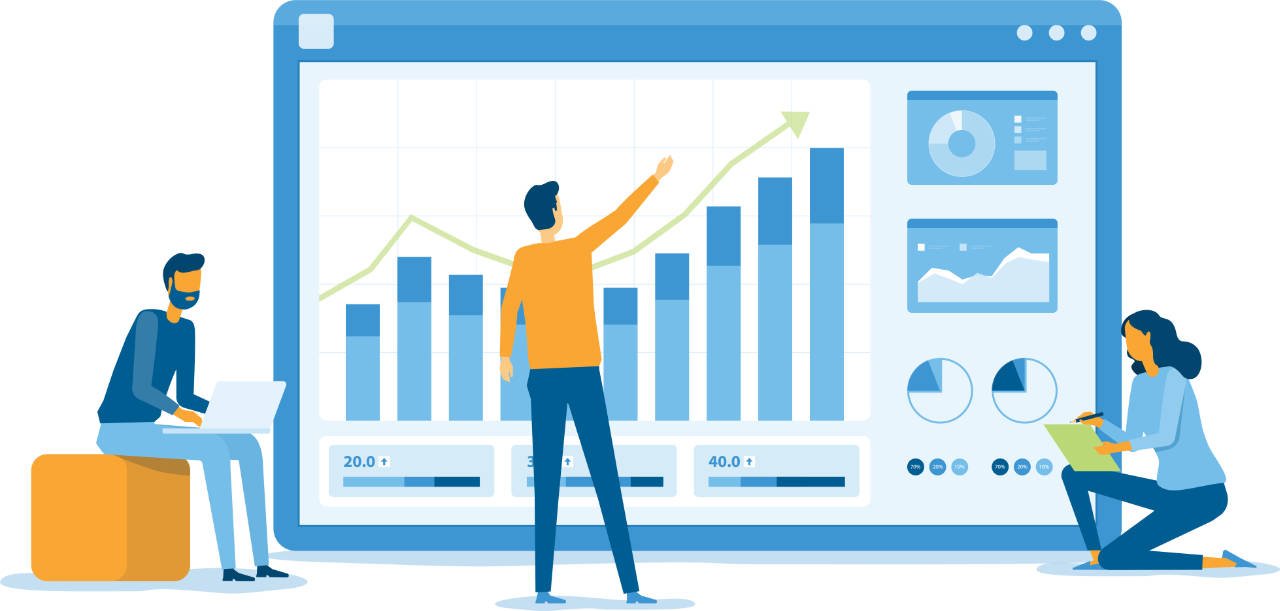Keeping up with the competition in today’s business climate isn’t always easy – but it pays to make the most of the digital tools available to you. Google holds a massive 93% share of the UK search engine market and if you’re a business owner, you already know how valuable it is to get your company on that first page of search results.
What might surprise you, though, is that Google has a suite of powerful, free tools that can help boost your rankings and make running your business easier.
Start using these essential resources to improve your online presence and streamline operations – with these tools in your kit, you could be well-positioned for sustainable growth in 2025 and beyond.
Top 10 free Google tools
Google Analytics
Why use it?
Google Analytics provides a comprehensive look at your audience and how they interact with your business. It gives you the insights you need to improve your site’s performance and increase engagement. Overall, it’s a great tool for achieving better results across all areas of your digital marketing strategy.
How does it work?
Google Analytics is an essential tool for any business aiming to understand its audience and make informed, data-driven decisions. With the latest version, Google Analytics 4 (GA4), businesses can now track both web and app traffic in a single platform, offering a more unified view of customer journeys across devices and channels.
Using Google Analytics, you can monitor key metrics like traffic sources, user demographics, popular pages and conversion rates. This insight allows you to understand what’s working and what needs improvement, helping you tailor strategies for maximum engagement. GA4 also offers predictive analytics, which uses machine learning to provide insights like purchase probability and potential churn rates. Businesses can use this to anticipate customer needs and take proactive steps to retain them.
It also enables customer event tracking, so you can set specific goals, like purchases or sign-ups, and measure their performance. With this level of detail, you can refine your marketing strategies and focus on high-performing campaigns, ultimately driving a higher ROI.
Read more about the top marketing analytics tools for business.
2. Google Search Console
Why use it?
Google Search Console (GSC) gives you the data you need to keep your site visible, performing well and ready to attract more search traffic.
How does it work?
If you’re looking to improve your website visibility in search results, then Google Search Console is a must-have tool for your business. It provides valuable insights into how your site is performing in search and highlights opportunities to improve your SEO strategy. Google Search Console offers data on keyword rankings, click-through rates and impressions, giving you insight into which search queries are driving traffic to your site.
One of Google Search Console’s standout features is its ability to help you troubleshoot technical issues. This essential Google SEO tool identifies indexing issues – such as pages that aren’t being crawled by Google – and provides guidance on how to fix them to ensure all relevant pages are visible to Google.
Google Search Console also allows you to monitor your site’s backlink profile, showing you which external sites link to yours. This information is crucial for managing your off-page SEO strategy and understanding your site’s authority.
For businesses focusing on local SEO, GSC can provide insights into your performance on local search queries, helping you understand how effectively you’re reaching nearby customers. You can also check for mobile usability issues, ensuring your site is optimised for the growing number of mobile users.
Discover Submerge’s SEO agency services where we make full use of GSC.
3. Google Business Profile
Why use it?
Google Business Profile not only helps you connect with local customers but also improves your online presence and is valuable for building credibility around your business – all at no cost to you.
How does it work?
Does your business rely on local customers? If so, Google Business Profile is essential. With a business listing, your company details appear on Google Search and Maps, making it easier for potential customers to find you. You can list practical information like your working hours, location and contact info, and also add photos, post updates and respond to reviews. It gives people a real feel for your business before they even walk through the door.
Google Business Profile is also one of the best ways to boost your local SEO. Maintaining an active, up-to-date listing allows you to improve your chances of showing up in those valuable ‘near me’ searches, which are especially important as more people search on mobile devices. The tool also offers insights that show how customers are finding you, where they’re coming from and what actions they’re taking – whether it’s calling, visiting your website or requesting directions.
4. Google Tag Manager
Why use it?
Google Tag Manager (GTM) is a tool that makes managing your website’s tracking tags a breeze. It’s the go-to tool for tracking exactly what matters to your business and staying flexible with your marketing strategy.
How does it work?
Google Tag Manager gives you control over your site’s tracking without the hassle of constantly updating your site’s code. Instead, you can use GTM to add and modify tags – such as those used for Google Analytics, conversion tracking or remarketing – without needing a developer’s help. It’s a real-time-saver, allowing you to quickly make adjustments and add new tags as your marketing campaigns evolve.
GTM also allows you to set up custom triggers to track specific user actions that matter to your business. These might be clicks on a button, video views or form submissions. With this data at your fingertips, you get a much clearer view of what’s working – and what’s not – on your site, allowing you to fine-tune the user experience.
5. Google Trends
Why use it?
Google Trends is the go-to tool for staying in touch with what’s popular and relevant. It helps you stay ahead of the curve and allows you to tap into the conversations your customers care about. Use it to boost your content strategy.
How does it work?
Google Trends shows you the hottest topics people are searching for in real-time, as well as long-term trends and seasonal spikes, giving you a clear picture of where the public interest lies. This tool is invaluable for planning content, campaigns or even new products, helping you align your business with topics people are actually talking about.
One of the best features of Google Trends is its ability to narrow down by location, time frame, and category, so you can see what’s trending specifically in your area or industry. You can compare keywords, spot emerging topics and find those ‘breakout’ terms that might give you an edge if you incorporate them into your content strategy. Also, it’s an ideal resource for SEO, as tapping into trending searches can help to improve your website’s visibility when people are actively searching for those topics.
Read about why SEO fails and what you can do about it.
6. Google Ads
Why use it?
When it comes to reaching customers who are ready to take action, Google Ads is one of the most powerful tools available. It allows you to reach an audience that’s ready to buy and provides the data to ensure you’re making the most of your ad spend. It’s a direct route to increasing visibility, traffic and conversions for your business.
How does it work?
With Google Ads, you can create highly targeted campaigns that show up where people are searching – whether it’s on Google Search, YouTube or across the web on Google’s Display Network. You control the budget, audience targeting and ad formats, so you can tailor your campaigns to hit exactly the right people at the right time.
One of the greatest advantages of Google Ads is the range of targeting options. You can reach users based on keywords, demographics, location, interests and even previous interactions with your brand. Google Ads also provides detailed reporting, showing you which ads and keywords are driving clicks, conversions and sales. With this level of insight, you can continuously refine your campaigns to maximise ROI.
Learn more about Submerge’s Google Ads and PPC paid advertising services.
7. Google PageSpeed Insights
Why use it?
If you want to know how well (or how badly) your website performs in terms of speed and user experience, Google PageSpeed Insights is your go-to tool. It helps you deliver a seamless user experience by keeping your site fast and efficient, which can lead to higher engagement, better search rankings and, more importantly, more conversions.
How does it work?
PageSpeed Insights analyses your site’s loading speed on both desktop and mobile, providing a score along with actionable recommendations to improve performance. With online users expecting fast load times, especially on mobile, even a slight delay can impact user experience and conversion rates.
The tool breaks down your performance by identifying areas that need improvement, such as image optimisation, caching and code minification. It’s also a valuable SEO tool since page speed is a ranking factor in Google’s algorithm. Faster sites tend to rank high in search results, giving you a competitive advantage.
Learn more about how Submerge can improve your website speed with our web design agency services.
8. DevTools
Why use it?
DevTools is an essential toolkit for anyone managing or optimising a website. It’s your command centre for website optimisation helping you to deliver a better, faster user experience while staying ahead of technical issues that could impact your search rankings.
How does it work?
DevTools is built directly into the Chrome Browser and offers a range of debugging and analysis features that allow you to inspect every detail of your site’s performance. This makes it easier to catch issues before they impact user experience. From HTML to CSS inspection to JavaScript debugging and network performance monitoring, this tool gives you the insights you need to keep your website running smoothly.
One key feature is Lighthouse, which audits your site performance, accessibility and SEO best practices. It’s a one-stop solution for identifying areas for improvement. It also allows you to understand how your site stacks up in critical areas that affect both users and search engine rankings. DevTools allows for Network Analysis, showing how resources load on your site, which is perfect for pinpointing anything that might be slowing down the user experience.
9. Merchant Center
Why use it?
Google Merchant Center is a must-have if you’re selling products online. It helps you put your products directly in front of shoppers at the moment they’re searching, giving you a competitive edge and driving qualified traffic to your online store.
How does it work?
This platform enables you to upload your product details directly to Google, making them visible across Google Shopping, Search and even YouTube. With Merchant Center, your products can reach a wider audience as they appear in Google Shopping ads and free listings, providing potential customers with the information they need to make buying decisions.
Setting up a Merchant Center account allows you to manage product details like pricing, availability and descriptions, ensuring that customers see the most accurate and up-to-date information. It also integrates with Google Ads, so you can run Shopping ads that showcase your products directly in search results, complete with images, prices and shop names.
Read SEO for ecommerce – everything you need to know.
10. Looker Studio
Why use it?
Looker Studio simplifies complex data, turning it into actionable insights that help your team make better, faster decisions. Its flexible, easy-to-share reports keep everyone on the same page, helping you communicate data insights effectively across your business.
How does it work?
Looker Studio (formerly Google Data Studio) is Google’s tool for creating interactive, customisable data visualisations. This platform lets you transform raw data from multiple sources, like Google Analytics, Google Ads and Search Console, into insightful, shareable dashboards and reports. With Looker Studio, you can bring all your data together in one place, making it easier to track key metrics and identify trends. Ultimately, it helps you make data-driven decisions.
Looker Studio’s drag-and-drop interface means you can create charts, graphs and tables, and its customisation options let you tailor reports to display the information that matters most. You can set up real-time data updates, apply custom filters and easily share reports with team members so everyone can stay aligned on your goals.
Since Looker Studio is integrated with Google’s suite of business tools, you can easily connect to a wide range of data sources. It also supports non-Google data sources, so you can combine your internal and external data for a comprehensive view of your performance.
Submerge creates bespoke Looker Studio reports and dashboards as part of our SEO services.
Ready to take your business to the next level? If you’re looking for expert guidance, our team offers tailored SEO services to help you make the most of tools and increase your search rankings.
Book a free consultation and let’s build a strategy that works for your business!
01/12/2025
The best AI tools for SEO in 2026
AI tools can help businesses improve SEO performance and…
28/11/2025
The common paid search advertising mistakes hurting your ROI
Discover how to optimise paid search advertising and avoid…
21/11/2025
Social search: what it is and how to embrace it
Social media is rapidly changing how target customers…
15/11/2025
Survive Black Friday with our Black Friday SEO tips
Ensure that your business survives and thrives during the…
01/11/2025
9 creative B2B marketing ideas to attract more customers
Don't fall into the trap of thinking your B2B marketing has…








